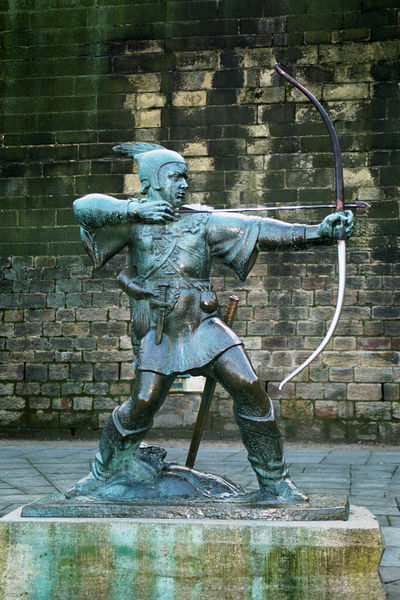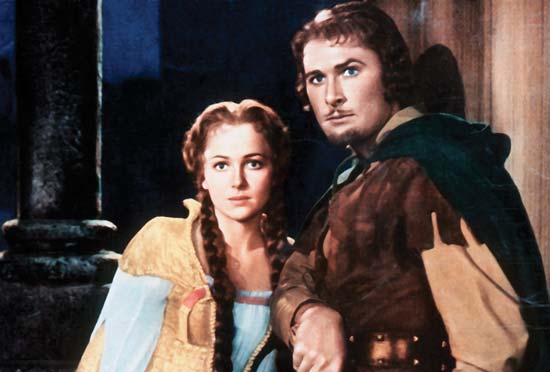|
pay
off his mortgage to an abbot, but this may merely indicate that no parallels
have survived.
The
earliest surviving text of Robin and Marion is a musical play entitled “Le jeu
de Robin et de Marion” (ca.1284) written by Adam de la Halle (ca1240–?1288)
and found in the book Norton Anthology of Western Music Volume:1 (pages
46–47).
The
next surviving Robin Hood text is “Robin Hood and the Monk”. This is
preserved in Cambridge University manuscript Ff.5.48, which was written shortly
after 1450. It contains many of the elements still associated with the legend,
from the Nottingham setting to the bitter enmity between Robin and the local
sheriff.
The
first printed version is A Gest of Robyn Hode (c.1475), a collection of separate
stories that attempts to unite the episodes into a single continuous narrative.
After this comes “Robin Hood and the Potter”, contained in a manuscript of
c.1503. “The Potter” is markedly different in tone from “The Monk”:
whereas the earlier tale is ‘a thriller’ the latter is more comic, its plot
involving trickery and cunning rather than straightforward force. The difference
between the two texts recalls Bower’s claim that Robin-tales may be both
‘comedies and tragedies’. Other early texts are dramatic pieces such as the
fragmentary Robyn Hod and the Shryff off Notyngham (c.1472). These are
particularly noteworthy as they show Robin’s integration into May Day rituals
towards the end of the Middle Ages.
The
plots of neither “the Monk” nor “the Potter” are included in the Gest;
and neither is the plot of “Robin Hood and Guy of Gisborne” which is
probably at least as early as those two ballads although preserved in a more
recent copy. Each of these three ballads survived in a single copy; this should
serve as a warning that we do not know how much of the medieval legend has
survived, and what has survived is not necessarily typical of the medieval
legend. It has been argued that the fact that the surviving ballads were
preserved in written form in itself makes it unlikely they were typical; in
particular stories with an interest for the gentry were by this view more likely
to be preserved. The story of Robin’s aid to the “poor knight” that takes
up much of the Gest may be an example.
The
character of Robin in these first texts is rougher edged than in his later
incarnations. In “Robin Hood and the Monk”, for example, he is shown as
quick tempered and violent, assaulting Little John for defeating him in an
archery contest; in the same ballad Much the Miller’s Son casually kills a
“little page” in the course of rescuing Robin Hood from prison. No extant
ballad actually shows Robin Hood ‘giving to the poor’, although in a “A
Gest of Robyn Hode” Robin does make a large loan to an unfortunate knight
which he does not in the end require to be repaid.; and later in the same ballad
Robin Hood states his intention of giving money to the next traveler to come
down the road if he happens to be poor.
The
20th century has grafted still further details on to the original legends. The
film The Adventures of Robin Hood portrayed Robin as a hero on a national scale,
leading the oppressed Saxons in revolt against their Norman overlords while
Richard the Lionheart fought in the Crusades; this movie established itself so
definitively that many studios resorted to movies about his son (invented for
that purpose) rather than compete with the image of this one.
Since
the 1980s, it has become commonplace to include a Saracen among the Merry Men, a
trend which began with the character Nasir in the Robin of Sherwood television
series. Later versions of the story have followed suit: the 1991 movie Robin
Hood: Prince of Thieves and 2006 BBC TV series Robin Hood each contain
equivalents of Nasir, in the figures of Azeem and Djaq respectively.
The
Robin Hood legend has thus been subject to numerous shifts and mutations
throughout its history. Robin himself has evolved from a yeoman bandit to a
national hero of epic proportions, who not only supports the poor by taking from
the rich, but also heroically defends the throne of England itself from unworthy
and venal claimants.
|



